Saola: 20 Years Later
Posted by: Loren Coleman on May 21st, 2012

The 20th anniversary discovery of one of the largest recent mammals to be found is celebrated during May 2012. But the animal, so newly revealed, may be extinct before we see its 40th anniversary.

The saola, Vu Quang ox or Asian unicorn, also, infrequently, Vu Quang bovid (Pseudoryx nghetinhensis), is one of the world’s rarest mammals. It is a forest-dwelling bovine found only in the Annamite Range of Vietnam and Laos.
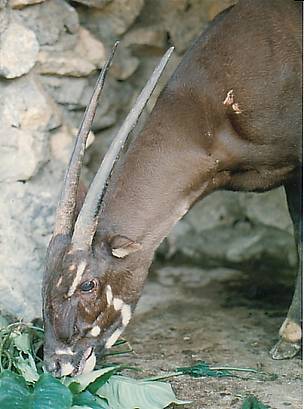
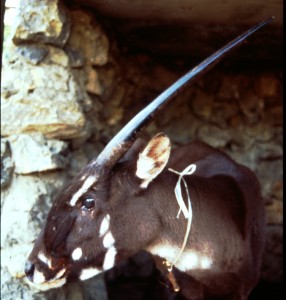
Female saola, Lak Xao, Bolikhamxay Province, Laos, 1996. Photo: WWF.
The name saola has been translated as spindle[-horned] although the precise meaning is actually “spinning-wheel post horn.” The name comes from a Tai language of Vietnam but the meaning is the same in the Lao language. The specific Latin scientific name nghetinhensis refers to the two Vietnamese provinces of Nghe An and Ha Tinh while Pseudoryx acknowledges the animal’s similarities with the Arabian or African oryx. Hmong people in Lao refer to this beast as saht-supahp, a term derived from Lao meaning “the polite animal,” because it moves quietly through the forest. Other names used by minority groups in the Saola’s range are lagiang (Van Kieu), a ngao (Ta Oi) and xoong xor (Katu). In the press, Saola have been referred to as Asian unicorns. The appellation is apparently due to the saola’s rarity and apparently gentle nature and perhaps because both the saola and the oryx have been linked with the unicorn (when viewed from the side, only one horn is visible to some observers). There is no known link with the mythical beast; nor with the “Chinese unicorn,” the qilin.
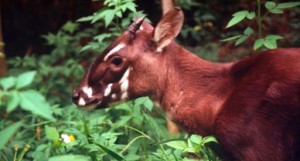
Saola, 2008.
The saola stands about 34 inches at the shoulder and weighs approximately 41 pounds. The coat is a dark brown with a black stripe along the back. Its legs are darkish and there are white patches on the feet, and white stripes vertically across the cheeks, on the eyebrows and splotches on the nose and chin. All saolas have slightly backward-curved horns, which grow to half a meter in length.
The species was confirmed and verified following a discovery of remains in May 1992 in Vu Quang Nature Reserve by a joint survey of the Ministry of Forestry and the World Wide Fund for Nature. The team found three skulls with unusual long straight horns kept in hunters’ houses. In their article, the team proposed “a three month survey to observe the living animal” but, 20 years later, there is still no reported sighting of a saola in the wild by a scientist.
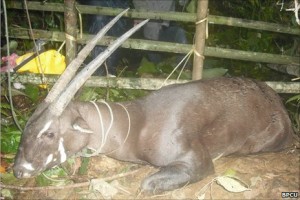
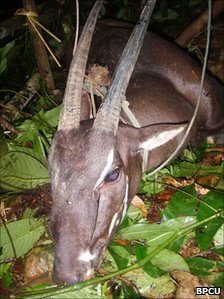
In late August 2010, a saola (shown above) was captured by villagers in Laos but died in captivity before government conservationists could arrange for it to be released back in to the wild. The carcass is being studied with the hope that it will advance scientific understanding of the saola.
The saola inhabits the Annamite Range’s moist forests and the Eastern Indochina dry and monsoon forests. They have been spotted in steep river valleys at about 300 to 1800 m above sea level. These regions are distant from human settlements, covered primarily in evergreen or mixed evergreen and deciduous woodlands. The species seems to prefer edge zones of the forests.
Saola stay in mountain forests during the wet seasons, when water in streams and rivers is abundant, and move down to the lowlands in winter. They are shy and never enter cultivated fields or come close to villages. To date, all known captive saola have died, leading to the belief that this species cannot live in captivity.
The saola belongs to the family Bovidae and genetic analysis places it in the tribe Bovini; in other words its closest relatives are cattle, true buffaloes, and bison. However its simple horns and teeth and some other morphological features are typical of less-derived or ‘primitive’ bovids. Saola are antelopes, in the sense that an antelope is any bovid that is not a cow, sheep, buffalo, bison, or goat. It is not known how many individuals exist, as only 11 have been recorded alive.
Local populations report having seen saola traveling in groups of two or three, rarely more.
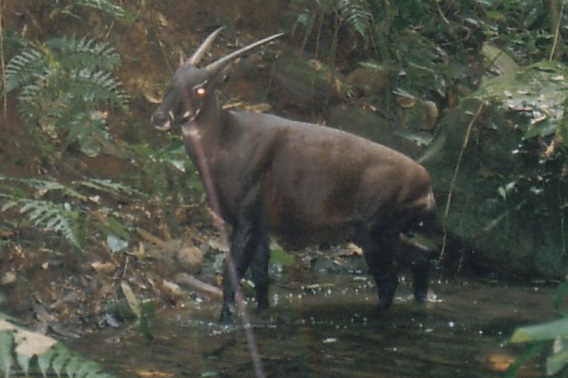
Saola caught on a camera-trapped in Bolikhamxay Province, central Laos in 1999. Photograph: William Robichaud/WWF International.
About Loren Coleman
Loren Coleman is one of the world’s leading cryptozoologists, some say “the” leading living cryptozoologist. Certainly, he is acknowledged as the current living American researcher and writer who has most popularized cryptozoology in the late 20th and early 21st centuries.
Starting his fieldwork and investigations in 1960, after traveling and trekking extensively in pursuit of cryptozoological mysteries, Coleman began writing to share his experiences in 1969. An honorary member of Ivan T. Sanderson’s Society for the Investigation of the Unexplained in the 1970s, Coleman has been bestowed with similar honorary memberships of the North Idaho College Cryptozoology Club in 1983, and in subsequent years, that of the British Columbia Scientific Cryptozoology Club, CryptoSafari International, and other international organizations. He was also a Life Member and Benefactor of the International Society of Cryptozoology (now-defunct).
Loren Coleman’s daily blog, as a member of the Cryptomundo Team, served as an ongoing avenue of communication for the ever-growing body of cryptozoo news from 2005 through 2013. He returned as an infrequent contributor beginning Halloween week of 2015.
Coleman is the founder in 2003, and current director of the International Cryptozoology Museum in Portland, Maine.










“20 years later, there is still no reported sighting of a saola in the wild by a scientist.”
For an animal hailed by all scientists as the biggest animal discovery of recent times. For an animal with, so far as is known, a very limited range.
(An animal, btw, for which there are unmistakable camera trap photos.)
Compare to an animal with a huge range; with a movie taken of it by one of only two expeditions to confirm it; that is apparently a higher primate, with the brains that entaiils; that, like the saola, is generally solitary; …
….and that, if you see one, no one believes you.
I hate to keep bringing the sasquatch up.
But that it remains unconfirmed is no surprise to people who understand animals, the outdoors, and human nature, and have thought about it a bit.
Toss the yeti and orang pendek in there, too.
DWA, I’m not sure whether you are saying that the discovery of the Saola makes Bigfoot sightings more or less believable, so I’m not sure what to say about your post.
So instead I’ll note that, in my opinion, there seems to be a trend for many cryptozoologists and enthusiasts to use such discoveries as evidence that cryptids like Bigfoot are real. The reasoning seems to go something like: if a critter like the Saola or the coelacanth is found and proved to exist, then how can people deny that Bigfoot is probably next to come to light?
I think this is a spurious argument which is based on emotion. There is no logical linkage between one animal existing and the existential status of another creature. The Coelacanth and Saola and other animals were proven to exist because the evidence is strong enough to convince skeptical scientists, even if they haven’t seen one for themselves. Evidence for the Sasquatch and some of the other well-known cryptids just isn’t strong enough to convince the scientific community at this time, so the creature remains unproven to science, even if Coelacanths, giant and colossal squids, Saola and other animals have been proven to exist and are now known to science.
The evidence for Sasquatch doesn’t even appear to be strong enough to convince Professor Jeff Meldrum, who finds the evidence intriguing and a reason to keep researching, but not enough to constitute definitive proof.
In the Saola example, after 20 years we have some excellent proof for the Saola, including multiple physical specimens (definitive, extant, irrefutable specimens) and what appear to be excellent photographs (clear, crips, high resolution, acquired from camera traps.) The Sasquatch evidence does not rise to this level after 50 years. Maybe that will change. It would be interesting and exciting if it did. But for now we wait, and all the coelacanths and Colossal Squid in the ocean can’t change that.
Massachusetts: no, actually, you’ve missed what’s interesting.
Here’s what’s interesting: the skeptical (really, it’s emotional) insistence on believing that if evidence doesn’t constitute proof, it’s nothing.
(I could go into the illogic that if we haven’t found a fossil or skeleton yet – and who says someone hasn’t? – we never will but I’ll spare you. I hope you know that’s nonsense.)
I base my opinion on the sasquatch on one single thing. And it’s not emotion. I use one thing, one thing only, and it’s one thing bigfoot ‘skeptics’ don’t, because they’re ignorant of it.
It’s EVIDENCE.
There is an overwhelming amount for the sasquatch, more than any other phenomenon in the entire history of science has had in its favor before being accepted by the society as real, by far. Anyone who does not know this is simply not reading.
Here’s why we who are in the know about this link things like coelacanth, saola and sasquatch: there is much MORE evidence for the latter than for the former two. The only difference is that science – but for a few intrepid researchers like Meldrum and Bindernagel (do you even know who Bindernagel is? He says the sasquatch has already been discovered) – doesn’t know this. They flat ignore it; and it’s obvious every time a ‘skeptical’ scientist opens his mouth.
No, my post is spot on. If I had to bet on it, right now, my whole salary for the rest of my life, on the sasquatch, real or not? there would be only one logical bet I – or you – could make.
Real.
Evidence says so. End of story.
If you don’t get this, argue with the scientists who disagree with you. On that topic, you severely misunderstand Meldrum, who has published a scientific paper providing an ichnotaxon for sasquatch tracks. Only the natural skepticism that all scientists must have to be true to their craft reins in his public pronouncements on the sasquatch. Oh, he thinks it’s real, all right. That’s why he wrote the paper, and the book. And why he is now linking yeren and sasquatch in another paper.
Emotionally, it can’t be real. THAT’s the emotional take.
Evidence, however, says emotion may be wrong. That happens a lot.
And I should add one thing.
The camera trap photos of saola aren’t nearly as clear as the Patterson-Gimlin film. The difference?
Emotional fog.
Now we do have specimens of saola, gathered by concerted effort by a scientific community convinced it would find them if it looked.
If that thing – the conviction – changes for the sasquatch, as the evidence says it should, we’ll have that specimen, soon enough. Probably sooner than we got the saola, once we decided to look.
“20 years later, there is still no reported sighting of a saola in the wild by a scientist.”
The sasquatch has that one beaten, by dozens at least.
The only difference?
Emotion says the sasquatch isn’t real.
Massachusetts:
OK, fine. It has occurred to me that sometimes I get a little, um, emotional about evidence. Sorry about that.
But my point, condensed, is:
What makes the saola important to unconfirmed cryptids like the sasquatch is that it was confirmed by following up pretty sketchy evidence, to hear most cryptid skeptics talk. Including, primarily, the eyewitness testimony of locals who had seen it, a rich vein that the mainstream doesn’t touch for hairy hominoids.
Eyewitnesses are frequently considered to constitute bad evidence. In fact, the quality of eyewitness evidence varies, and cannot be assessed at all unless it is examined against the actual situation on the ground. That happened for the saola. It hasn’t for the sasquatch; and there’s not really a good reason why, other than scientists’ emotional reaction to a higher primate in North America. As to other evidence, practically every kind an animal leaves, including skeletal remains and dead bodies, is reported for the sasquatch. The difference is that none of that evidence has wound up in the hands of a scientist who trusted it, understood what to do with it, and moved it forward. Or if it did, he’s not talking.
There is no reason for any scientist not to report a saola sighting. Yet in 20 years, none have?
There are plenty of good reasons – like $$$$ many of them – for someone making his living from science to stay as far as he can from cryptids. Even those who have dared freely allow that.
That last paragraph is the main reason – really the only one – that the sasquatch wasn’t confirmed in 1968, when it could and probably should have happened. That a big, dumb antelope/ox hid from science until 1992 – and a higher primate should have been confirmed at least 24 years before – says much about how much evidence there is for the sasquatch (and most of the pile has been amassed since then).
Thank you for your reply, DWA. Here are a few thoughts:
1. re: “do you even know who Bindernagel is? He says the sasquatch has already been discovered”
I’m not sure I like your tone here. The printed word can be an imperfect tool, but I’m sensing that your comment borders on an ad hominem slight. If I were to say something like “a scientist like Isaac Newton bases his theories on data” and then add “Do you even know who Isaac Newton is?” I think you’d find that a tad condescending.
I am aware of Dr. Bindernagel is. He is referenced throughout this site and has appeared in many documentaries. I find the notion that the Sasquatch has been proven to exist already untenable at this time, based on my current understanding.
2. re: “There is an overwhelming amount for the sasquatch, more than any other phenomenon in the entire history of science has had in its favor before being accepted by the society as real, by far. Anyone who does not know this is simply not reading.”
I find this statement very hard to accept. But I would like to understand how you come to that conclusion. I recognize I could be wrong but I just don’t see it. Please kindly point me in the direction of something I can read or review that will help me understand where you are coming from on this.
3. re: “Here’s what’s interesting: the skeptical (really, it’s emotional) insistence on believing that if evidence doesn’t constitute proof, it’s nothing.”
Isn’t the whole point of collecting evidence to prove something? If the evidence doesn’t add up to proof, then what is it does it actually add up to?
Are you saying that there’s some middle ground, where you can still believe without enough evidence to actually prove something? I honestly don’t understand your point. How would this specifically relate to proof for the Sasquatch?
4. re: “Real. Evidence says so. End of story.”
If this were so the scientific community would have accepted this evidence by now. Look at the world we live in compared with a few hundred years ago. We’ve been transformed by new scientific ideas, supported by the appropriate evidence.
If scientists had enough respect for quality evidence to drop a creationist model for the origin of species in favor of a scientific model, the theory of evolution, (back in the 19th century, no less) then surely scientists could easily accept the existence of the Sasquatch in the face of overwhelming, high quality evidence today. If scientists could drop the earth centered model in favor of helio centrism, then surely they would accept the existence of the Sasquatch, if the appropriate evidence exists.
Scientists are not afraid to scrutinize and accept good evidence and change our conceptions of this universe and how it works, and that’s been proven time and time again, despite the enormous socio-political consequences that such shifts engender.
If the evidence for Sasquatch and other cryptids meets such scrutiny then science will accept them into a revised taxonomy.
What evidence are scientists missing?
Massachusetts: let’s answer some of these.
1. OK, you know who Bindernagel is. Have you read what he’s written? Your comment indicates you haven’t. It’s kind of important. His discovery claim is well backed up, and thoroughly steeped in the history of science as a practice. You’d have to read the book to know how well. Both of Bindernagel’s books, and Meldrum’s, and J.Robert Alley’s “Raincoast Sasquatch,” and Meldrum’s ichnotaxonomy paper, and every report on both bfro.net and texasbigfoot.com, at a minimum, are Sasquatch 001. You should read some Krantz, too. And John Green’s database (although many reports from that are written up by Bindernagel). Anyone who thinks this is too much, well, shouldn’t be opining here. I mean, they can; it’s just an uninformed opinion. At least I only offer opinions on things I know something about. Isn’t that reasonable? I think so.
(Cryptozoology is zoology. People don’t get degrees in zoology by not studying.)
2. I come to that conclusion because I have read a LOT of the evidence. To go to a point you made: I find it a bit condescending when people who haven’t read up on the evidence (a) think they know more about it than me, or the scientists who agree with me, and (b) expect me to present it all here. I expect folks to get where I am the way Bindernagel, and Meldrum, and I, did. Reading and thought, a lot of it, as are required with any scientific topic, which this is. There is copious evidence. If you know what I do, you know that it is stretching credulity to the logical extreme to postulate, without proving it, that anything other than the putative source is producing all this evidence. It simply boggles. The “extraordinary claim” requiring “extraordinary proof” in this discussion is that that credulity stretch is what’s required to grasp the truth. I’d bet everything I own that it isn’t, if for some reason I had to bet, and I’m not a betting man. Evidence does that.
3. Your questions are the wrong ones. Here are the questions to ask:
– Why do mainstream scientists not visit this evidence at all? (Trust me, they don’t. As I said: every single time they open their mouths their ignorance is the first thing out.)
– Isn’t the process of evidence adding up to proof a, well, process? That takes time? Far more than it should have, in this case?
– If the evidence hasn’t added up to proof yet, does that mean it never will?
– Isn’t the only difference between evidence and proof that science accepts the latter? (Yes.)
– Why do scientists feel so comfortable broadcasting their ignorance of this topic? Why do they consider it perfectly OK to say things they would never consider worthy of a scientist were this not the topic? Particularly when scholars in relevant fields disagree?
“Are you saying that there’s some middle ground, where you can still believe without enough evidence to actually prove something? I honestly don’t understand your point. How would this specifically relate to proof for the Sasquatch?”
That’s a middle ground? You don’t “believe” anything in science. Not if evidence sufficient to you for proof has not been offered. Here – for the God Knoweth How Many time on this site – is what I think: the evidence for hairy hominoids is the most compelling for any natural phenomenon that science has not already proven. Time to follow it up. Right, Science? (Right.)
My bet above is an up or down based, you bet, on inconclusive evidence. My point in making that hypothetical bet is that the evidence only allows a person who is interested in keeping his money to bet it one way – the way the evidence tells him to. I wouldn’t bet on whether the giraffe is real, would I? (Unless someone would bet me it isn’t. I’m not that nice.)
4. “…the scientific community would have accepted this evidence by now…”
No they wouldn’t. Because – the evidence says – they haven’t. And they should at least look at it. And I know they should because of what I’ve read, what I’ve thought about what I’ve read…and how it is ably backed up by scholars in eminently relevant fields who agree with me. Scientists are human like everyone else. A constant in the history of science is the premature discovery (read Bindernagel!) rejected for years, even decades, by a mainstream that simply ignores the evidence. Here is just one more instance.
Every scientist – trust me, every one – who posts skeptically on this topic reveals himself in the grip of assumptions unchallenged by a review of the evidence. They say positively silly things. Like that the sasquatch can’t be real because there’s no fossil evidence – when paleontologists make routine bets on how many dinosaurs still remain to be discovered. Like that there’s not enough food – when big groups of Indians foraged in the same forests for generations; when forests themselves couldn’t exist if most of the organic produce didn’t rot away uneaten. Just silly stuff. Don’t make omnipotency protests for the scientific mainstream; its own history shows that a very bad idea.
What evidence are scientists missing?
Practically all; or they just couldn’t say what they say.
The saola is what happens when a scientist pays attention to the kind of evidence everyone says is useless when a bipedal ape generates it.
I don’t think there’s anything wrong with following up on sketchy anecdotal evidence. It’s logical to do so in order to find better evidence. You must, however, find better evidence in order to support the claim, as I’m sure you would agree. Clearly you believe that high quality evidence has been discovered in large quantities to support the existence of the Sasquatch. I still question that but I’m willing to look closer at the evidence you have in mentioned, specifically the works of Bindernagel, Meldrum, et al. Which book would you recommend first?
I realize you haven’t mentioned much about photographic evidence, except perhaps PG briefly. But on that field I feel very strongly: I can tell you right now that the photographic evidence presented for the Sasquatch is in my opinion atrocious. I find PG interesting but not definitive, and there isn’t much more out there to my knowledge that isn’t a blobsquatch, which is useless, or something that can be easily hoaxed. Our Saola photographs, though few in number, far exceed the Sasquatch field in quality. It’s not a sketchy critter that might be a Saola but also might be a deer doing a back flip or a bear cub maybe if you look at it another way–it’s a clear direct image. That’s the kind of quality and clarity I need to see in order to trust such evidence, and I’m not alone. High quality pics of multiple specimens and from different sources. I don’t see that extant for the Sasquatch. If I’m wrong I’m happy to learn where to look. But an argument about how difficult or scary it is to photograph the creature isn’t a valid evidentiary argument. Either we have the images or we don’t. Alleged secret photographs locked away from the public by research projects don’t count either, at least until those photographs are disseminated for review and critique. And gray abstracted images that look like an airbrush experiment certainly don’t count. That’s what I’ve been seeing lately, unfortunately.
I have concerns also about your comments regarding skeletal materials and such. Either there are or there aren’t. It appears that there are rumors and stories that there are, as told on the Lindsay blog frequently for example, but no actual bones to point to in actual institutions, and none that have been written up in a peer reviewed journal for sure. That’s what counts. Feeling that they are out there somewhere but have been ignored or misunderstood isn’t evidence and it’s not helpful. Those are stories to explain a lack of evidence, and a lack of evidence isn’t helpful.
It’s my hope that the DNA studies being conducted now, not only Ketchum’s but the new Oxford University study, will shed light on this topic and ultimately decide this issue in a definitive way. But we are still waiting for that and likely will for a long time to come, so for now that’s out of the running.
I do think you have a point about the refutations that skeptical scientists sometimes make, i.e., food sources, fossil evidence, etc. However, they don’t have to make those refutations and probably shouldn’t. I don’t see how they are helpful. The only relevant issue is what evidence do we have now?
Massachusetts: some thoughtful stuff in there. Let’s take a crack at it.
“Better evidence” is usually found only after the anecdotal evidence is followed up. In the case of the sasquatch that’s actually far from sketchy. One reason I recommend reading every report on every database you can, if you are interested in this, is that you won’t usually be halfway through before you are pretty much convinced that people aren’t sharing notes or making this up. (How many unicorn databases are there?) People are describing, with extraordinary guidebook consistency, an animal that they are all seeing. One characteristic of all that stuff you see on Youtube: there is nothing about it that persuades one, least of all the obvious guy in suit. Read a sasquatch database and you’ll find that the words are worth a thousand photographs.
About which: I’d agree with you on the photo evidence. (All but Patty. If that “blurry” film were anyone I know I’d recognize him; that is state-of-art for that film at that time for a subject at that distance. I watched a lot of home movies as a kid; I know.) Here’s the short form: all that wonderful nature photography we are all so used to seeing usually takes weeks in the field per minute to come up with. And that’s fulltime pros, looking for animals whose habits we know and whose habitats we can precisely pin down. Some guy with a cell camera – any camera – walking around the woods won’t get a good photo of anything that isn’t acclimated to humans. Watch the “Planet Earth” sequences on how they got the shots. Each one of those segments involved far more time than Patterson took; and Patterson’s is one of only two true sasquatch expeditions in history. And the other one wasn’t focused, at all, on field photos. Weekenders can forget it right now. Which rules out, handily, practically everybody.
So “an argument about how difficult” it is to photograph the creature is, in fact, a valid argument. Time isn’t money; it’s far more valuable. And until it is devoted to this, which yes, requires the money too, forget good pictures. Period.
Game cameras occasionally photograph elusive animals – known ones, whose habitats we’ve pinned down, whose sign we trust and use to set up the cameras. You kind of need that for game cams to work without extreme luck.
I’d read Meldrum’s book first. Bindernagel’s two (both) second. (Read “North America’s Great Ape” first, “The Discovery of the Sasquatch” second.) You will think of Bindernagel’s: he’s citing these stories. Any could have been faked or just made up. I had read almost none of them before I read him; I found them compelling. Why? They are absolutely typical of the hundreds of others I’ve read, which square exactly with the overview of the evidence by those who (may, though I wouldn’t bet on it) have read more than me. Alley’s, even though it focuses on a relatively small geographic area, contains one of the best scholarly overviews of the topic I have read.
And with skeletal materials, it’s a naive notion – as with photos – that found in the woods equals in the possession of science. Take a look at my blog on the Minaret skull for my thoughts on that. You won’t write it up if you know you’re going to be laughed at, unless you are one tough, and totally convinced, fella. As the folks I cite above are. And they have the scholarly chops that insulates them from the you’re-fired consequences, although promotions, yeah, good luck there. But somebody has to get them something first. If I were trying to get them a deer bone it would be a search, and I live in an area saturated with those.
DNA will confirm nothing until a specimen is in hand. There have been a number of “unknown primate” samples. Without the type specimen, scientists say so-what.